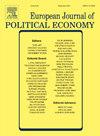从年轻开始:年龄如何限制政治参与
IF 2.4
3区 经济学
Q2 ECONOMICS
引用次数: 0
摘要
利用瑞典政治家的丰富数据,本文记录了第一次选举经验对未来政治参与的重要性。一个基于出生月份和选举时间之间的相互作用的不连续性差异设计,使我们能够比较第二次在选举中投票和竞选公职的个人与第一次参加选举的年龄相仿的个人的行为。我们发现,虽然两个群体的投票率保持不变,但更苛刻的政治参与措施,如竞选公职和当选,分别上升了10%-14%和60%-70%,与第二次参与。我们讨论了各方筛选在产生这些结果中的作用。然后,我们探讨了将最低年龄限制降低到16岁对政治家年龄概况的影响。本文章由计算机程序翻译,如有差异,请以英文原文为准。
Starting young: How age limits shape political participation
Using rich data on Swedish politicians, this paper documents the importance of the first experience of an election on future political participation. A difference-in-discontinuity design, based on the interaction between the month of birth and the timing of elections, allows us to compare the behavior of individuals who can vote and run for office in an election for the second time to individuals of similar age who participate for the first time. We find that, while turnout rates of both groups remain the same, more demanding measures of political engagement, such as running for office and being elected, rise by 10%–14% and 60%–70%, respectively, with the second participation. We discuss the role of parties’ screening in generating these results. We then explore the consequences of lowering the minimum age limit to 16 years old on the age profiles of politicians.
求助全文
通过发布文献求助,成功后即可免费获取论文全文。
去求助
来源期刊

European Journal of Political Economy
Multiple-
CiteScore
3.40
自引率
10.00%
发文量
106
期刊介绍:
The aim of the European Journal of Political Economy is to disseminate original theoretical and empirical research on economic phenomena within a scope that encompasses collective decision making, political behavior, and the role of institutions. Contributions are invited from the international community of researchers. Manuscripts must be published in English. Starting 2008, the European Journal of Political Economy is indexed in the Social Sciences Citation Index published by Thomson Scientific (formerly ISI).
 求助内容:
求助内容: 应助结果提醒方式:
应助结果提醒方式:


